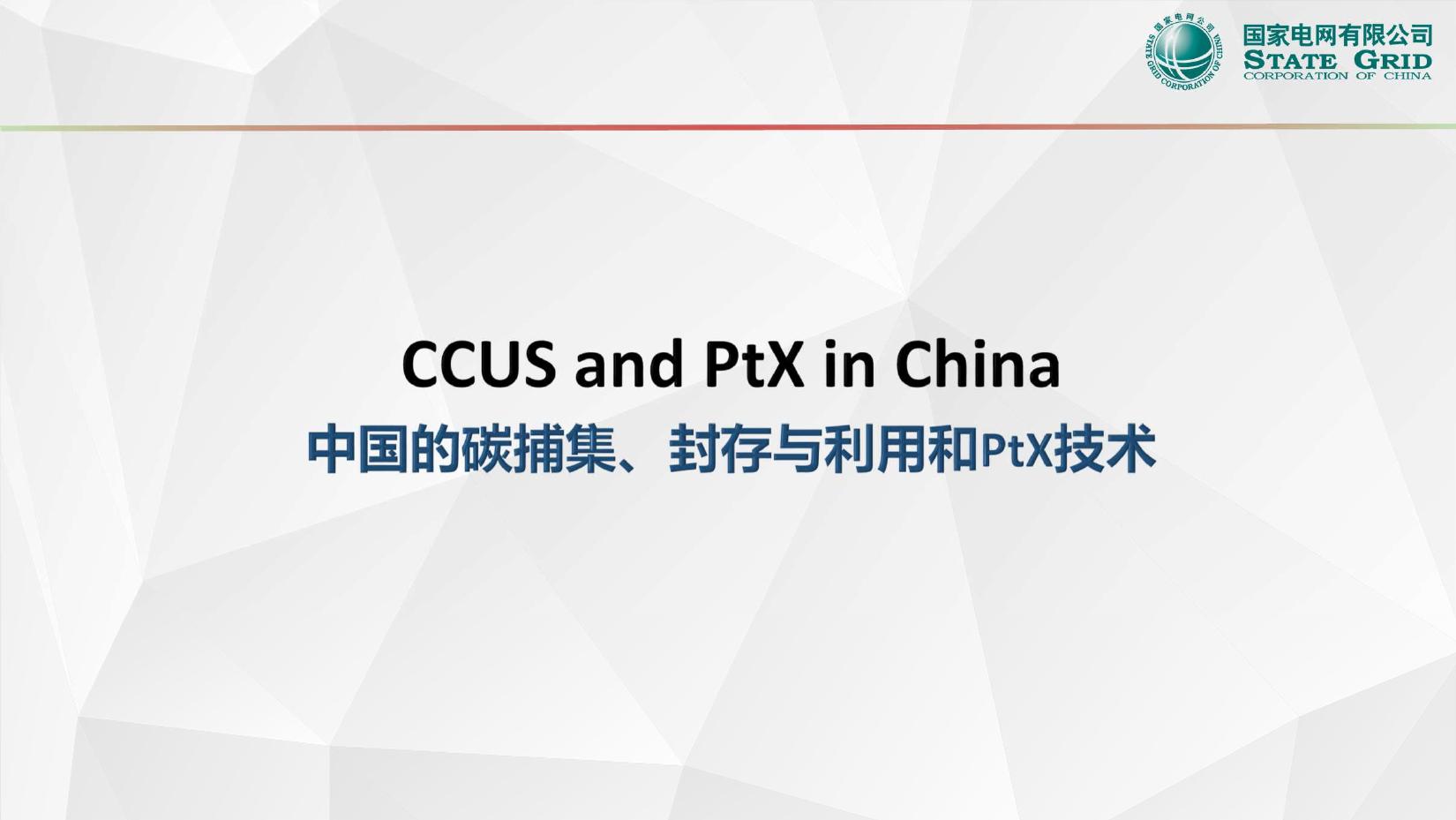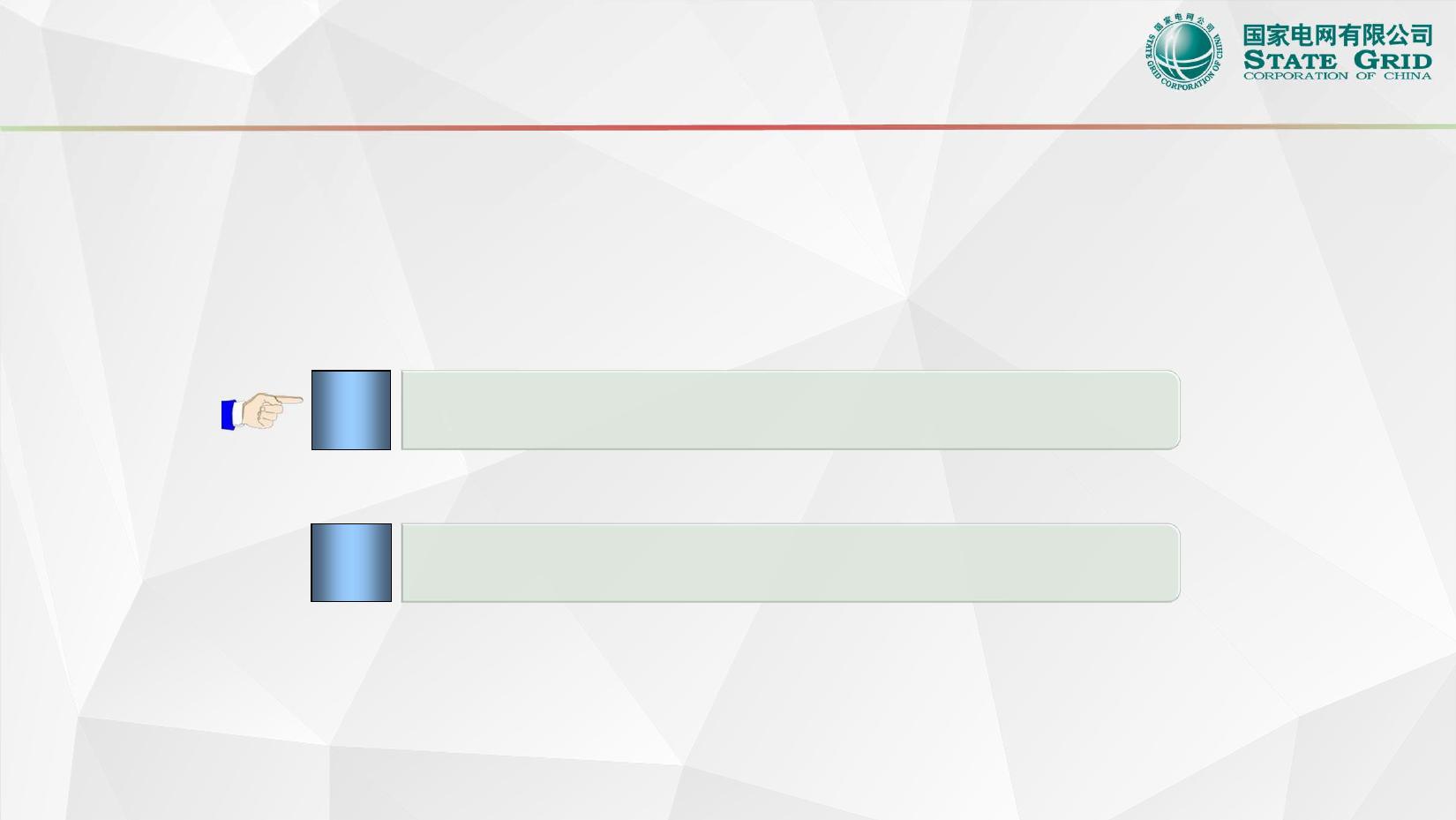ECECPInvestmentandTechnologiesforNet-zeroCarbonInfrastructureECECP净零碳基础设施投资和关键技术研究StateGridEnergyResearchInstitute12October2023国网能源研究院有限公司2023年10月12日ContentsICCUS碳捕集、利用与封存2PtX电转其他能源2(1)ImportanceofCCUS碳捕集、利用与封存技术的定位CCUSistheonlytechnologicaloptiontorealizelow-carbonutilizationoffossilenergy.CCUS是目前实现化石能源低碳化利用的唯一技术选择。•Itisestimatedthatby2050,fossilenergywillaccountfor10%-15%ofChina'senergyconsumption.•到2050年,化石能源仍将扮演重要角色,占中国能源消费比例的10%~15%。CCUScanmaintaintheflexibilityofpowersystemtorealizecarbonneutrality.CCUS是碳中和目标下保持电力系统灵活性的主要技术手段。•Byavoidanearlyphasingoutofcoal-firedpowerstations,thenecessarysupportforsysteminertiaandfrequencycontrolisthenguaranteedwhenfacingthegreatvolatilityofrenewableenergyandpotentialseasonalpowershortages.•火电加装CCUS是具有竞争力的重要技术手段,可实现近零碳排放,提供稳定清洁低碳电力,平衡可再生能源发电的波动性,并在避免季节性或长期性的电力短缺方面发挥惯性支撑和频率控制等重要作用。3(1)ImportanceofCCUS碳捕集、利用与封存技术的定位CCUSisafeasibletechnologyoptionforhard-to-abatesectors,likesteelandcement.CCUS是钢铁水泥等难以减排行业低碳转型的可行技术选择。•Afterimplementingmeasureslikeefficiencyimprovement,rawmaterialsubstitution,andetc,itisestimatedthat34%ofcarbonemissionsinthesteelindustryand48%ofcarbonemissionsinthecementindustryarehardtoabate.•预计到2050年,钢铁行业通过采取工艺改进、效率提升、能源和原料替代等常规减排方案后,仍将剩余34%的碳排放量,即使氢直接还原铁(DRI)技术取得重大突破,剩余碳排放量也超过8%。水泥行业通过采取其他常规减排方案后,仍将剩余48%的碳排放量。CCUScoupledwithrenewableenergycouldrealizenegativeemissions.CCUS与新能源耦合的负排放技术是实现碳中和目标的重要技术保障。•CCUScouplingwithbio-energy,usuallyreferredtoasBECCS,couldrealizenegativeemssions.Negativeemissiontechnologiescanneutralizegreenhousegasemissionsandprovideimportantsupportforachievingthegoalofcarbonneutrality.•BECCS及其他负排放技术可中和该部分温室气体排放,推动温室气体净零排放,为实现碳中和目标提供重要支撑。4(2)CCUSprojectsinChina碳捕集、利用与封存项目开展情况CCUSProjectsinChinaThereareabout40CCUSprojectsthatareinoperationorunderconstructioninChina.Thecapturecapacityisaround3milliontons/yearandthecumulativestoragecapacityis2milliontons.中国已投运或建设中的CCUS示范项目约为40个,捕集能力300万吨/年,累计封存200万吨CO2。CCUSprojectsinChinaSource:ChinaCCUSAnnualReport2021.(2)CCUSprojectsinChina碳捕集、利用与封存项目开展情况CCUSProjectsinChinaCCUSprojectsinChinaTheexistingCCUSpilotSource:ChinaCCUSAnnualReport2021.demonstrationprojectsfocusondemonstratingcarboncapturetechnologyandEORtechnology.Large-scale,full-chainprojectsarerare.现有的CCUS试点示范项目主要关注展示碳捕集技术和EOR技术。大规模、完整链条的项目相对较少。Chinahasthedesigncapabilityofalarge-scale,full-processsystemandisactivelypreparingforthefull-chainCCUSindustrialclusters.中国具备大规模、全过程系统的设计能力,并积极准备建设完整链条的CCUS工业集群。(3)CCUStechnologycostsinChina技术成本情况China'sCCUSdemonstrationprojectsaresmallinscaleandexpensive.ThecostofCCUSmainlyincludeseconomiccostsandenvironmentalcosts.中国的CCUS示范项目规模较小且成本较高。CCUS的成本主要包括经济成本和环境成本。Economiccostsincludefixedcostsandoperatingcosts.经济成本包括固定成本和运营成本。Environmentalcostsincludeenvironmentalrisksandenergyconsumption.环境成本包括环境风险和能源消耗。2025-2060年CCUS技术的成本CostforCCUSTechnologiesin2025-2060Year202520302035204020502060燃烧前捕集Pre-100-18090-13070-8050-7030-5020-40combustion捕集技术燃烧后捕集Post-230-310190-280160-220100-18080-15070-120combustionCapture富氧燃烧Oxy-fuel300-480160-390130-320110-23090-15080-130combustion运输Transport罐车Truck0.9-1.40.8-1.30.7-1.20.6-1.10.5-1.10.5-1(RMB/t·km)管道Pipeline0.80.70.60.50.450.4封存Storage50-6040-5035-4030-3525-3020-25Source:ChinaCCUSAnnualReport2021.7(3)CarboncapturetechnologyinChina碳捕集技术现状China'sthermalpowerindustrywillreachaBesttimeEnergypeakforunitrenewalfrom2035to2045.forCCSConsumtionConsideringthedevelopmentofcarbonretrofitcapturetechnology,before2035,thefirst-generationcapturetechnologyshouldbeEnergyconsumptionforfirst-themainstreamwhileafter2035,the-generationcapturesecondgenerationtechnologyshouldbethetechnologymainstream.Energyconsumptionforsecond-generationcapturetechnology2035年前后将是捕集技术实现代际升级的关Costforfirst-generation键时期。我国火电行业在2035-2045年间将迎capturetechnology来机组更新高峰。综合考虑火电行业的发展规Costforsecond-generation律与捕集技术的发展趋势,2035年前应以采capturetechnology用第一代捕集技术的存量火电机组改造为主,2035年后应以采用二代捕集技术的新建火电机组为主。Levelisedadditionalelectricitycostsforcoal-firedpowerunitssuitableforretrofitting适合改装的燃煤发电机组的电力水平化附加成本Notes:thefirst-generationcapturetechnologyarereadytobeusedonalargescale.Thesecond-generationcapturetechnology'senergyconsumptionandcostwilldecreasetomorethan30%comparedtothefirst-generation.注:第一代捕集技术指现阶段已能进行大规模示范的技术,如胺基吸收剂、常压富氧燃烧;第二代捕集技术指技术成熟后能耗和成本可比成熟后的第一代8技术降低30%以上的新技术,如新型膜分离技术、新型吸收技术等。(4)CarbonstorageinChina碳封存技术现状ThepotentialforCO2storageinChinaisabout1.21-4.13trilliontons.中国地质封存潜力约为1.21~4.13万亿吨。ThepotentialforCO2storageThepotentialforCO2storageinChinaOilfields:SongliaoBasin,BohaiBayBasin,OrdosBasinandJunggarBasin.CO2-EOR,5.1billiontons.石油区域:松辽盆地、渤海湾盆地、鄂尔多斯盆地、准噶尔盆地。CO2-EOR,51亿吨。Gasfields:OrdosBasin,SichuanBasin,BohaiBayBasinandTarimBasin.Depletedgasfields:15.3billiontons;CO2-EGR:9billiontons.天然气区域:鄂尔多斯盆地、四川盆地、渤海湾盆地和塔里木盆地。已枯竭的天然气田:153亿吨;CO2-EOR,90亿吨。Ref:RoadmapforCarbonCaptureandStorageDemonstrationandDeployment.(4)CarbonstorageinChina碳封存技术现状ThepotentialforCO2storageinChinaisabout1.21-4.13trilliontons.中国地质封存潜力约为1.21~4.13万亿吨。ThepotentialforCO2storageThepotentialforCO2storageinChinaDeepsalineaquifer:2420billiontons.SongliaoBasin:694.5billiontons;TarimBasin:552.8billiontons;BohaiBayBasin:490.6billiontons;SubeiBasin:435.7billiontons;OrdosBasin:335.6billiontons.深层咸水含气层:24200亿吨。松辽盆地:6945亿吨;塔里木盆地:5528亿吨;渤海湾盆地:4906亿吨;苏北盆地:4357亿吨;鄂尔多斯盆地:3356亿吨。Ref:RoadmapforCarbonCaptureandStorageDemonstrationandDeployment.(5)Retrofittingcoal-firedpowerstationswithCCUS煤电机组的CCUS改造SuitabilityCriteriaforPowerPlants发电厂适用性标准ProximitytoCO2storagesite≤800km;距离二氧化碳储存地点≤800公里Unitage≤40years;使用年限≤40年Unitsize≥600MW,orthetotalamountofcapturableCO2≥10Mt/yearandannualoperatinghours≥4000.单元容量≥600兆瓦,或可捕获二氧化碳总量≥10百万吨/年且年运行小时数≥4000。DistributionofcoalpowerplantswithsuitabilityresultsSource:DecarbonizingtheCoal-FiredPowerSectorinChinaviaCarbonCapture,GeologicalUtilization,andStorageTechnology11(5)Retrofittingcoal-firedpowerstationswithCCUS煤电机组的CCUS改造Atleast613GWor508plants(73%oftotalinstalledcapacityor63%oftotalcoalplants)appearsuitableforCCUSretrofits.ThetotalCO2emissionisabout2.2Gt/year.至少有613千兆瓦或508座电厂(占总装机容量的73%或总煤电厂的63%)适合进行碳捕获利用与储存(CCUS)的改造。总二氧化碳排放约为每年22亿吨。Almostallselectedcoalpowerplantswithoneormoregeneratingunitsofmorethan600MWcapacitywerebuiltbetween2005and2015.Theseplantsstillhavemanydecadesofexpectedoperationallife.几乎所有含有一个或多个容量超过600兆瓦发电单元的燃煤电厂都建于2005年至2015年之间,这些电厂仍有数十年的预期运营寿命。DistributionofcoalpowerplantswithsuitabilityresultsSource:DecarbonizingtheCoal-FiredPowerSectorinChinaviaCarbonCapture,GeologicalUtilization,andStorageTechnology12(5)Retrofittingcoal-firedpowerstationswithCCUS煤电机组的CCUS改造RetrofittingCCUStotheexistingcoalfleetwouldincreasetheLCOEsbyanaverageof24.1-37.2USD/MWhfortheentirefleetwithbetween50%and85%netmitigationrates.将碳捕获利用与储存(CCUS)改装到现有的燃煤电厂将使整个电厂的电力生产成本(LCOEs)增加,净减排率在50%至85%之间的电厂平均增加24.1-37.2美元/兆瓦时。Source:DecarbonizingtheCoal-FiredPowerSectorinChinaviaCarbonCapture,GeologicalUtilization,andStorageTechnologyContentsICCUS碳捕集、利用与封存2PtX电转其他能源14(1)TechnologiesincludedinPtXPtX中的技术MostofthePtXtechnologiesarebasedonpower-to-hydrogen,exceptforpower-to-coolandpower-to-heat.除了电转冷、电转热以外,大部分PtX技术都是基于电转氢。MaintechnologiesofPtXNameAdvantagesLimitationTechnologiesStagePowertoCool(P2C)clean,convenient-airconditionerscommecialapplication电转冷清洁、便利lowenergyefficiencyina空调商业应用completecycle,highcostPowertoHeat(P2H)clean,safe,heatpumps,electricinitialstageofcommecialconvenient在一次完整循环中,能效较低、boiler,electricheaterapplication电转热成本较高清洁、安全、便利热泵、电锅炉、电暖器商业应用初始阶段PowertoGas(P2G)clean,flexiblelowenergyefficiencyinaelectrolysersdemonstration&initialstagecompletecycle,highcostofcommercialapplication电转气清洁、灵活电解槽在一次完整循环中,能效较低、示范&商业应用初始阶段PowertoLiquid(P2L)orclean成本较高electrolysers,PowertoFuels(P2F)synthesisdemonstration清洁highcost电转液或电转燃料电解,合成示范成本高PowertoChemicals(P2C)cleanhighcostelectrolysers,demonstrationorPowertoProducts(P2P)synthesis清洁成本高示范电转化学或电转产品电解,合成PowertoPower(P2P)longstoragetimehighcost,lowefficiencyfuelcellsdemonstration电转电长周期存储成本高,能效低燃料示范Source:ResearchonP2XTechnologyProgressanditsParticipationinPowerSystemOperationOptimizationSimulation(2)HydrogenproductionandconsumptioninChina中国氢能的产消Thecurrenthydrogenproductionisfossil-fuelbased(coal,naturalgasandindustrialby-product).Thelargestshareofhydrogendemandisfromthechemicalssectorfortheproductionofammonia(10.8milliontons/year,32.3%)andmethanol(9.1milliontons/year,27.2%).目前的氢气生产主要依赖化石燃料(煤炭、天然气和工业副产品)。氢气需求的最大份额来自化工行业,用于氨的生产(每年1080万吨,占32.3%)和甲醇的生产(每年910万吨,占27.2%)。Unit:×104tonCoalRefining&CoalChemicalIndustryNaturalAmmoniagasTransportationElectrolysisOtherpureMethanolCoalBy-productBy-productNaturalgasElectrolysisOthermixedThesupplystructureofhydrogeninChinaThehydrogenflowdiagraminChinaRef:Chinahydrogenenergyandfuelcellindustrydevelopmentreport2020.16(3)Scaleofpower-to-hydrogeninChina中国电制氢的规模Theproductionofhydrogenin2019is33.42milliontons,around1/3oftheworld'stotal(115milliontons).2019年,中国的氢气产量为3342万吨,约占全球总产量(1.15亿吨)的三分之一。GreenHydrogenNow:161projectsareplanned,12areinoperation,22underconstruction,23100tonsperyear.计划161个项目,12个在运营,22个在建,每年23100吨。2030:7.7milliontonsperyear,100GWelectrolysers.770万吨/年,100GW电解槽。2060:75-100millionDevelopmentofrenewablehydrogencapacityunder100GWscenariostonsperyear.每年0.75-1亿吨。Source:OpeningChina’sGreenHydrogenNewEra:A2030RenewableHydrogen100GWRoadmap17(4)Technicaliussesandcostofpower-to-hydrogeninChina中国电制氢的技术问题及成本ALKPEMSOECAEMEfficiency(kWh/Nm3)能效4.253.0-4.04.5-5.5Singleelectrolyser(Nm3/h)1400200--单个电解槽Stage应用阶段CommercialApplicationInitialStageofCommercializationDemonstrationR&DGreenHydrogenProductionTheprotonexchangemembraneandcatalyst(platinum,iridium)arehighlydependentonimport.质子交换膜和催化剂(铂、铱)高度依赖进口。Asthescaleofelectrolyzersexpandsto100GW,theinvestmentcostofALKelectrolyzersinChinawilldecreasefrom2000RMB/kWin2020to1500RMB/kWin2030.随着电解槽规模扩大到100GW,中国的ALK电解槽投资成本将从2020年的每千瓦2000元降低到2030年的每千瓦1500元。Theaveragetotalcostofgreenhydrogenwilldropto13RMB/kg.绿色氢气的平均总成本将下降到每千克13元。ProductioncostofgreenhydrogenSource:OpeningChina’sGreenHydrogenNewEra:A2030RenewableHydrogen100GWRoadmap18(5)Industrialapplicationofpower-to-hydrogeninChina中国电制氢技术的工业应用Greenhydrogenprojectsarebeccomingmoreandmorecommon.However,hydrogenproducersarereluctanttointeractwiththepowergrid.绿氢项目越来越常见,然而产氢端与电网互动较少。RepresentativeProjectsXinjiangbase:windInnerMongoliabase:Northeastbase:windandsolarbasedwindandsolarbasedpower,biomasshydrogenNingxia:Nationaldemonstrationprojectforhydrogenproductionhydrogenproduction+production+pipelineH2producedthroughelecytrolysispoweredby+newpowersystemchemicalindustrymixingsolarenergy,largestintheworld,200MWPV+30000Nm3/heletrolysers,H2usedforNingdongbase:PVNorthChinabase:windchemicalsynthesis.hydrogen+chemicalpowerbasedhydrogen+industrytransportation+steel宁夏:通过太阳能电解制氢的国家示范项目,是世界上最大的项目,包括200MW光伏发电和Sichuanbase:hydrobasedEastChinabase:wind30000Nm3/h的电解槽,生产的氢气用于化学合成。powerbasedhydrogen+hydrogen+ammoniasynthesis+transportation+tradeXinjiang:Kuchaproject,willbuild300MWPVstation(618GWhofelectricity)and52000shippingSouthChinabase:windNm3/hofelectrolysers,H2usedforrefining.powerbasedhydrogen+transportation+trade新疆:库车项目,将建设300MW光伏电站(发电量为618GWh)和52000Nm3/h的电解槽,用于炼油过程中的氢气生产。Source:OpeningChina’sGreenHydrogenNewEra:A2030RenewableHydrogen100GWRoadmap19(6)Hydrogenandthepowergrid氢能和电网的关系ReducingVREcurtailment降低弃风弃光率Long-termenergystorage长周期储能Hydrogenstorage,hydrogen-fueledgasturbinesandfuelcellscanrealizelong-termenergystorage.储氢结合燃氢机组或燃料电池,保障新能源为主体下的全时段电力电量平衡。Providinggrid-balancingservicesviaelectrolysers为电网提供调峰、调频等辅助服务TransportingrenewablepoweroverlongdistancesasH2将可再生能源转化为氢能实现大范围优化配置LittleinvestmentisneededtoadaptnaturalDifferentPower-hydrogenCouplingModesgasinfrastructuretotransporthydrogen.power–hydrogencouplingattheloadside受端电氢耦合power–hydrogencouplingatthesourceside源端电氢耦合利用新能源尖峰出力制氢,利用天然气管道或氢气管道进行输送,缓解电网外送新能源的压力。Ref:ComparisonofDifferentCouplingModesbetweentheforpowertransmission输电PowerSystemandtheHydrogenSystemBasedonaPower–forhydrogentransport输氢HydrogenCoordinatedPlanningOptimizationModelforlocalusage就地利用20Thankyou!21



 VIP
VIP VIP
VIP VIP
VIP VIP
VIP VIP
VIP VIP
VIP VIP
VIP VIP
VIP VIP
VIP VIP
VIP